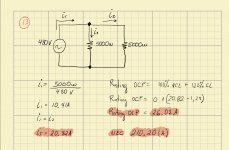Hi there.
You are employed in a large industrial plant. A 480-V, 5000-W heater is used to melt lead in a large tank. It has been decided that the heater is not sufficient to raise the temperature of the lead to the desired level. A second 5000-W heater is to be installed on the same circuit.
What will be the circuit current after installation of the second heater, and what is the minimum size circuit breaker that can be used if this is a continuous-duty circuit?
Is this well done?
when do we use the 80%?
I am confused with that
Thanks.

You are employed in a large industrial plant. A 480-V, 5000-W heater is used to melt lead in a large tank. It has been decided that the heater is not sufficient to raise the temperature of the lead to the desired level. A second 5000-W heater is to be installed on the same circuit.
What will be the circuit current after installation of the second heater, and what is the minimum size circuit breaker that can be used if this is a continuous-duty circuit?
Is this well done?
when do we use the 80%?
I am confused with that
Thanks.


